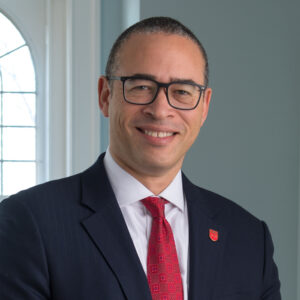Writer: Esteban Pages
 3 min read May 2023 — New Brunswick has long been known as Hub City. Staying true to that moniker, New Brunswick is laying the foundation for the HELIX project: an innovation hub gathering the best that the state has to offer in terms of research, healthcare, education and innovation. Rutgers University President Jonathan Holloway, Jaymie Santiago, president & CEO of New Brunswick Tomorrow and Christopher Paladino, president & CEO at the New Brunswick Development Corporation (DEVCO) discuss how the city is growing and the investments that are paving the way forward.
3 min read May 2023 — New Brunswick has long been known as Hub City. Staying true to that moniker, New Brunswick is laying the foundation for the HELIX project: an innovation hub gathering the best that the state has to offer in terms of research, healthcare, education and innovation. Rutgers University President Jonathan Holloway, Jaymie Santiago, president & CEO of New Brunswick Tomorrow and Christopher Paladino, president & CEO at the New Brunswick Development Corporation (DEVCO) discuss how the city is growing and the investments that are paving the way forward.
What major highlights from New Brunswick’s state of affairs would you like to share?
Jonathan Holloway, President, Rutgers University
Jonathan Holloway: We broke ground on two important sites for the City of New Brunswick and Rutgers. One is the new tower for the Cancer Institute of New Jersey, a new investment in cutting-edge clinical cancer care and research. But even more prominent is the New Jersey Health + Life Science Exchange (HELIX), a public-private partnership which will be developed by the New Brunswick Development Corporation (DEVCO) on a site across from the New Brunswick train station. It is a three-building site and one building will house the new Robert Wood Johnson Medical School – a Rutgers medical school next to Robert Wood Johnson Hospital. It’s a marriage of academic training, education, academic research, corporate research and laboratory space. When fully realized, there will be a return on investment of enormous value to the City of New Brunswick and the State of New Jersey.
Rutgers has a tremendous economic impact. The university is a good neighbor to the City of New Brunswick. We see ourselves as an engine of social mobility throughout New Jersey. We do a lot of work in the healthcare space by staffing local clinics serving the non-Rutgers population. We pull in students from the larger metropolitan area around New Brunswick. About 35% of our students are from low-income families, and English is not their first language for a significant portion. These are individuals whose chances of success would be limited if it weren’t for a place like Rutgers. Rutgers is a facilitator and accelerator of the potential for success for many young people. One of our goals is to ensure that students get to know the city better and their first jobs are within the New Brunswick metropolitan area. That’s where the HELIX–the innovation hub in downtown New Brunswick–when fully realized, will be a fantastic transition vehicle for our graduates to get research experience and placement with companies doing development work and then go on from there.
 Jaymie Santiago, President & CEO, New Brunswick Tomorrow
Jaymie Santiago, President & CEO, New Brunswick Tomorrow
Jaymie Santiago: This city of New Brunswick has a spotlight on it. We are confident in our success but we also have to keep in mind that we just came out of an unprecedented pandemic. So, there is still a lot to do; while funding trends are shifting and people are quick to move past it, we can’t move forward without fixing those fault lines that revealed themselves during the pandemic. The next few years will force organizations like mine to reconsider strategic priorities based on those lessons so we can do things better. As we think about the future, we are always trying to figure out what are the most pressing issues our residents are facing and aligning that with resources that continually shift us into new directions.
Over the course of our City’s history, we have always been a place where sojourners and immigrants can call their home. When you have large swaths of people coming into a city, they bring with them music, art and culture, and that is what creates community – a powerful connection and unity of purpose. Knowing that history, we celebrate the diversity in communities, to improve open spaces and inspire people to make this city their home. You cannot have revitalization without considering all parts of a community. We are a small urban city with a population of 60,000 but that feels like the right size to test models that can be used across the country and I believe that here, in the “Hub City” of New Brunswick, NJ, we are poised to be the model of what revitalization in urban centers looks like for the rest of the country. Our mayor is at the center and is the driver of the ship and has been doing so for 30 years.
Our biggest funder right now is the State of NJ, Department of Community Affairs. They just awarded us a $1 million tax credit to continue the work we are doing to revitalize the neighborhood and the corridor. With those dollars, we have been able to do things like launch a small business micro-grant program, allowing businesses to apply for up to $15,000 for any number of needs they have for their business. This effort is through the Neighborhood Revitalization Tax Credit Program (NRTC).
Christopher Paladino, President & CEO, New Brunswick Development Corporation (DEVCO)
Christopher Paladino: The Jack & Sheryl Morris Cancer Center of Rutgers Cancer Institute of New Jersey is an extraordinary milestone for New Brunswick and the country. It will be the first and only freestanding cancer hospital and research center in New Jersey. The building is an expansion of the current Institute of about 250,000 square feet. We’re building an additional 500,000 square feet. The original building will continue to stay as a research facility. The facility will double the number of people who can be cared for.
We’re one of the few urban centers in New Jersey that have grown exponentially over the last several decades. The New Jersey Innovation Hub project, now known as the HELIX, went from 170,000 square feet, where we wanted to create a startup, second-tier companies from university students and retiring professionals looking to take discovery to the next step with commercialization. The building is now over 530,000 square feet and includes Rutgers translational research. This is the only place in the country where there is translational science. There is a large incubator project that is fostering collaboration and a medical school. We are moving the Rutgers medical school from the suburbs to downtown, which will foster all kinds of exciting things. We hope it encourages more medical students to pursue doctorates and become research physicians.
The state of New Jersey is putting about $500 million into the HELIX either through tax credits or direct funding. This project is poised to create a net benefit to the state of over $500 million in 10 years. Translational research will bring $800 million of new NIH funding in the first 10 years and that we will create over $100 million of new licenses and patents. Many companies that are founded grow and expand and hire people within 15 to 20 miles of where they were founded. We’re fortunate in New Jersey to have the largest population of engineers and doctors on a per capita basis than anywhere in the world.
In our second and third phases, we want to attract established technology and biotech companies to be in the ecosystem. We’re not building structures but creating an ecosystem where the private sector, academic scientists and students can all interact and share ideas. The world has changed dramatically, and 60% of the drugs taken to market today don’t come from behind the gates of a pharmaceutical company that they’ve worked on for the last 10 years.

